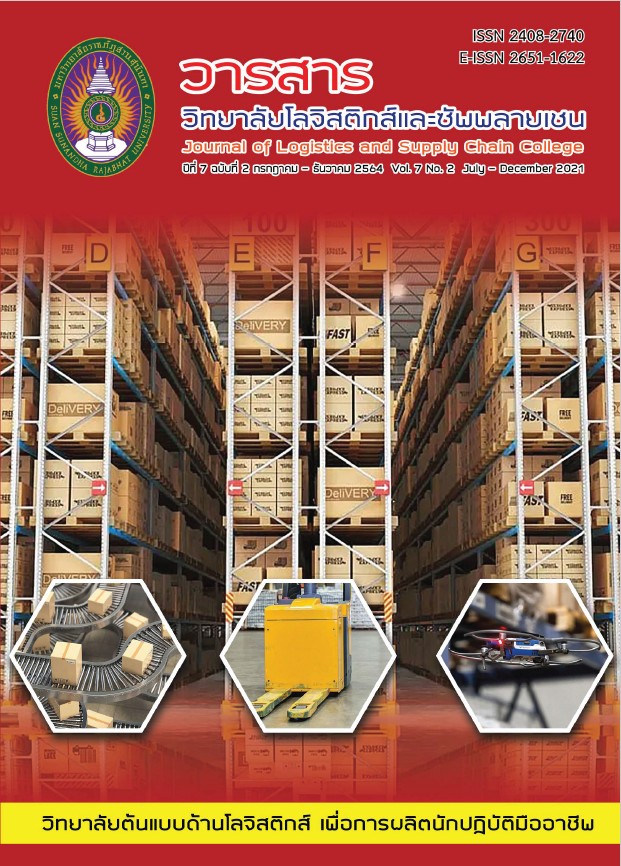การประยุกต์ใช้กระบวนการวิเคราะห์เชิงลำดับชั้นในการคัดเลือกผู้ขายอย่างยั่งยืน กรณีศึกษา บริษัทเอบีซี
คำสำคัญ:
ธุรกิจค้าปลีกอาหาร, การคัดเลือกผู้ขายอย่างยั่งยืน, การวิเคราะห์เชิงลำดับชั้นบทคัดย่อ
งานวิจัยนี้มีวัตถุประสงค์เพื่อ กำหนดเกณฑ์และแนวทางการคัดเลือกผู้ขายอย่างยั่งยืนให้กับองค์กร และทำการคัดเลือกผู้ขายสินค้ากลุ่มอาหารและเครื่องดื่มที่เหมาะสมจากเกณฑ์ที่ได้ ขององค์กรกรณีศึกษาที่ดำเนินธุรกิจค้าปลีก การคัดเลือกเกณฑ์ที่ใช้ประเมินผู้ขายอย่างยั่งยืนได้มาจากการทบทวนวรรณกรรมและการระดมความคิดเห็นของผู้เชี่ยวชาญ เป็นผู้บริหารและผู้จัดการฝ่ายที่เกี่ยวข้องรวม 4 ท่าน จากนั้นใช้กระบวนการวิเคราะห์ เชิงลำดับชั้นเป็นเครื่องมือในการประเมิน ผลการวิจัย พบว่าเกณฑ์การคัดเลือกผู้ขายอย่างยั่งยืนที่เหมาะสมประกอบไปด้วยสามเกณฑ์หลัก ได้แก่ 1) ด้านเศรษฐกิจ ประกอบด้วยเกณฑ์ย่อย ด้านคุณภาพสินค้าหรือบริการ ต้นทุน การส่งมอบ และบริการ 2) เกณฑ์ด้านสิ่งแวดล้อม ประกอบด้วยเกณฑ์ย่อย ด้าน การจัดการสีเขียว การออกแบบเพื่อสิ่งแวดล้อม และ การบริโภคพลังงานและทรัพยากร และ 3) เกณฑ์ด้านสังคม ประกอบไปด้วยเกณฑ์ย่อย ด้านการรับผิดชอบต่อสังคม และสุขภาพและความปลอดภัย ผลการวิเคราะห์เชิงลำดับชั้น ค่าเฉลี่ยน้ำหนักความสำคัญของเกณฑ์หลักที่มากที่สุดคือ ด้านเศรษฐกิจ (0.731) รองลงมาคือด้านสิ่งแวดล้อม (0.188) และด้านสังคม (0.081) ตามลำดับ และผลการคัดเลือกผู้ขายพบว่า ค่าน้ำหนักทางเลือกของผู้ขายที่มีค่าสูงที่สุดคือผู้ขาย B (0.357) รองลงมาเป็นผู้ขาย D (0.256) ผู้ขาย C (0.232) และ ผู้ขาย A (0.155) ตามลำดับ ซึ่งเมื่อพิจารณาจากเกณฑ์หลักด้านเศรษฐกิจที่มีค่าน้ำหนักเกณฑ์สูงสุด พบว่าเกณฑ์ย่อย ด้านต้นทุนและด้านคุณภาพ ยังเป็นปัจจัยหลักที่ส่งผลให้ผู้ขาย B ถูกพิจารณาเลือกเป็นผู้ขายอันดับแรก โดยผลของงานวิจัยองค์กรสามารถนำไปต่อยอดสร้างคู่มือหรือแนวทางการคัดเลือกและประเมินผู้ขาย ภายใต้กรอบแนวทางแผนการพัฒนาที่ยั่งยืนขององค์กรได้
References
กรมส่งเสริมอุตสาหกรรม. (2562). ยุทธศาสตร์กรมส่งเสริมอุตสาหกรรม พ.ศ. 2562-2564. แผนยุทธศาสตร์กรมส่งเสริมอุตสาหกรรม พ.ศ. 2562-2564, 1-60.
ณัฐพร สว่างวงศ์สิน. (2555). การประยุกต์ใช้กระบวนการ AHP ในการประเมินผู้ขาย : กรณีศึกษา ธุรกิจค้าปลีกสินค้ากลุ่มห้องน้ำ. วิทยานิพนธ์บริหารธุรกิจมหาบัณฑิต สาขาบริหารธุรกิจ. กรุงเทพฯ: มหาวิทยาลัยธุรกิจบัณฑิต.
ณัฐพัชร์ อารีรัชกุลกานต์ และสมหญิง งามพรประเสริฐ. (2559). การพัฒนาแบบจำลองการวัดสมรรถนะสวนอุตสาหกรรมเชิงนิเวศในประเทศไทย. วารสารวิศวกรรมศาสตร์ มหาวิทยาลัยศรีนครินทรวิโรฒ, 11(2), 75-90.
วิฑูรย์ ตันศิริคงคล. (2542). AHP กระบวนการตัดสินใจที่ได้รับความนิยมมากที่สุดในโลก. กรุงเทพฯ: กราฟฟิค แอนด์ ปริ้นติ้ง เซ็นเตอร์.
ศราวุธ ไชยธงรัตน์ และ สุนาริน จันทะ. (2555). การกำหนดระดับสินค้าคงคลังสารองที่เหมาะสมสำหรับสินค้าประเภทสั่งทำ กรณีศึกษาบริษัทผลิตประตูหน้าต่าง. การประชุมวิชาการข่ายงานวิศวกรรมอุตสาหการ ประจำปี 2555, 346-352.
สมพงษ์ เหมบุตร. (2560). การศึกษาเกณฑ์การคัดเลือกผู้ผลิตชิ้นส่วนที่ยั่งยืนของผู้ผลิตฮาร์ดดิสก์ ตามแนวทาง Triple Bottom Line (TBL). วิทยานิพนธ์วิศวกรรมศาสตร์มหาบัณฑิต สาขาวิศวกรรมอุตสาหการ. กรุงเทพฯ: มหาวิทยาลัยธรรมศาสตร์.
Aminsoust, A., Ahmed, S., Saghafinia, A., Bahreininejad. (2012). Sustainable supplier selection: A ranking model based on fuzzy inference system. Applied Soft Computing, 12, 1668-1677.
Azadnia, A.H., Saman, M.Z.M. Wong, K.Y., Ghadimi, P., & Zakuan, N. (2012). Sustainable Supplier Selection Based on Self-organizing Map Neural network and Multi Criteria Decision Making Approaches. Procedia - Social and Behavioral Sciences, International Congress on Interdisciplinary Business and Social Science, 65, 879 – 884.
Bansod, S., Kubde, R. (2012). The Analytic Hierarchy Process Based Supplier Selection Approach for Collaborative Planning Forecasting and Replenishment Systems. International Journal of Engineering Research & Technology (IJERT), 1(7), 1-12.
Calik, A. (2019). A Multi-Criteria Evaluation for Sustainable Supplier Selection Based on Fuzzy Sets. Business and Economics Research Journal, 10(1). 95-113.
Chaharsooghi, S. & Ashrafi, M. (2014). Sustainable Supplier Performance Evaluation and Selection with Neofuzzy TOPSIS Method. International Scholarly Research Notices, 2014, 1-10.
Chaitonrat, S., Areerakulkan, N., Setthachotsombut, N. (2020). A Comprehensive Literature Review on the Relationship of Green Logistics and Lean Management on Firms’ Performance. Sciences and Business Management Graduate Conference 2020: SBC2020, 112-120.
Du, Y., Zhang, D., Zou, Y. (2020). Sustainable Supplier Evaluation and Selection of Fresh Agricultural Products Based on IFAHP-TODIM Model. Mathematical Problems in Engineering, Vol. 2020, 1-15.
Erdoğdu, M., Mermod, A., Yıldırım, O. (2016). Sustainable Supplier Evaluation and Selection Criteria . Social and Economic Perspectives on Sustainability, 31, 159-168.
Ghadimi, P. & Heavy, C. (2014). Sustainable Supplier Selection in Medical Device Industry: Toward Sustainable Manufacturing. Procedia CIRP, 15, 165 – 170.
Ghoushchi, J.S., Milan, M.D., & Rezaee, J.M. (2018). Evaluation and selection of sustainable suppliers in supply chain using new GP-DEA model with imprecise data. Journal of Industrial Engineering International, 14, 613–625.
Grover, R., Grover, Ra., Rao, V., & Kejriwal,. K. (2016). Supplier Selection Using Sustainable Criteria in Sustainable Supply Chain Management. World Academy of Science, Engineering and Technology International Journal of Economics and Management Engineering, 10(5),1175-1179.
Hendiani, S., Liao, H., Ren, R., Lev, B. (2020). A likelihood-based multi-criteria sustainable supplier selection approach with complex preference information. Information Sciences, 536, 135-155.
Holden, E., Linnerud, K., Banister, D. (2014). Sustainable development: Our Common Future revisited. Global Environmental Change, 26, 130–139.
Kubde, R., & Bansod, S.V. (2012). The Analytic Hierarchy Process Based Supplier Selection Approach for Collaborative Planning Forecasting and Replenishment Systems. International Journal of Engineering Research & Technology, 1(7), 1-12.
Memari, A., Dargi, A., Jokar, M., Ahmad, R., Rahim, R. (2019). Sustainable supplier selection: A multi-criteria intuitionistic fuzzy TOPSIS method. Journal of Manufacturing Systems, 50, 9-24.
Moktadir, A., Rahman, T., Sultana, R. (2017). Selection of Best Supplier by Using AHP Tool for Managing Risk Factors in Logistics: A Case of Leather Products Industry. Industrial Engineering & Management, 6(4), 1-7.
Nielsen, I.E., Banaeian, N,, Golinska, P., Mobli, H., & Omid, M. (2014). Green Supplier Selection Criteria: From a Literature Review to a Flexible Framework for Determination of Suitable Criteria. Logistics Operations, Supply Chain Management and Sustainability, 79-99.
Orji, I.J., & Wei, S. (2015). An innovative integration of fuzzy-logic and systems dynamics in sustainable supplier selection: A case on manufacturing industry. Computers & Industrial Engineering, 88, 1–12.
Ozturk, B. & Ozçelik, F. (2014). Sustainable Supplier Selection with A Fuzzy Multi-Criteria Decision Making Method Based on Triple Bottom Line. Business and Economics Research Journal, 5(3), 129-147.
Pishchulov, G., Trautrims, A. Chesney, T. Gold, S. Schwab, L. (2019). The Voting Analytic Hierarchy Process revisited: A revised method with application to sustainable supplier selection. International Journal of Production Economics, 211, 166–179.
Purvis, B., Mao, Y., Robinson, D. (2019). Three pillars of sustainability: in search of conceptual origins. Sustainability Science, 14, 681–695.
Saaty, T.L. (1980). The Analytic Hierarchy Process. McGraw-Hill, New York.
Sarkis, J., & Dhavale, D.G. (2015). Supplier selection for sustainable operations: A triple- bottom-line approach using a Bayesian framework. Int. J. Production Economics, 166, 177–191.
Taherdoost, H. (2017). Decision Making Using the Analytic Hierarchy Process (AHP): A Step by Step. International Journal of Economics and Management System, 2, 243-246.
Xu, L., Kumar, D.T., Shankar, K.M., Kannan, D., & Chen, G. (2013). Analyzing criteria and sub-criteria for the corporate social responsibility-based supplier selection process using AHP. International Journal of Advanced Manufacturing Technology, 68, 907–916.
Yu, C., Shao, Y., Wang, K., Zhang, L. (2019). A group decision-making sustainable supplier selection approach using extended TOPSIS under interval-valued Pythagorean fuzzy environment. Expert Systems With Applications, 121, 1-17.
Zafar, A., Zafar, M., Sarwar, A., Raza, H., Khan, T. (2019). A Fuzzy AHP Method for Green Supplier Selection and Evaluation. Proceedings of the Twelfth International Conference on Management Science and Engineering Management, 1355-1366.


